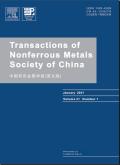High-temperature fracture behavior of Ti−22Al−26Nb with different featured microstructures
IF 4.7
1区 材料科学
Q1 METALLURGY & METALLURGICAL ENGINEERING
Transactions of Nonferrous Metals Society of China
Pub Date : 2025-04-01
DOI:10.1016/S1003-6326(24)66740-3
引用次数: 0
Abstract
The fracture behavior at high temperatures of the Ti−22Al−26Nb alloy, which features duplex lamellar, bimodal, and Widmanstätten structures, was studied. Samples of the alloy were prepared through compression deformation in the trans-phase region followed by subsequent heat treatment. The results indicate that at 650 °C, the fracture toughness of the Ti−22Al−26Nb alloy is increased by 41.7% compared to that with original microstructures. The content of the B2 phase significantly influences the inherent fracture toughness of the material, while the morphology and distribution of the precipitated phases primarily affect the tortuosity of the crack propagation path. Among the microstructural features, the morphology and geometric orientation of the lamellae most significantly impact the crack path; consequently, the Widmanstätten structure exhibits the most tortuous fracture path. Additionally, a predictive model for fracture toughness is developed, which effectively predicts the fracture toughness of Ti−22Al−26Nb alloys with various microstructures at 650 °C.
不同特征组织Ti - 22Al - 26Nb的高温断裂行为
研究了具有双片层、双峰和Widmanstätten结构的Ti−22Al−26Nb合金的高温断裂行为。通过在跨相区进行压缩变形,然后进行热处理,制备了合金样品。结果表明:在650℃时,Ti−22Al−26Nb合金的断裂韧性比原始组织提高了41.7%;B2相的含量显著影响材料的固有断裂韧性,而析出相的形貌和分布主要影响裂纹扩展路径的弯曲度。其中,薄片的形貌和几何取向对裂纹路径的影响最为显著;因此,Widmanstätten结构呈现出最曲折的断裂路径。建立了断裂韧性预测模型,有效地预测了不同组织Ti - 22Al - 26Nb合金在650℃下的断裂韧性。
本文章由计算机程序翻译,如有差异,请以英文原文为准。
求助全文
约1分钟内获得全文
求助全文
来源期刊
CiteScore
7.40
自引率
17.80%
发文量
8456
审稿时长
3.6 months
期刊介绍:
The Transactions of Nonferrous Metals Society of China (Trans. Nonferrous Met. Soc. China), founded in 1991 and sponsored by The Nonferrous Metals Society of China, is published monthly now and mainly contains reports of original research which reflect the new progresses in the field of nonferrous metals science and technology, including mineral processing, extraction metallurgy, metallic materials and heat treatments, metal working, physical metallurgy, powder metallurgy, with the emphasis on fundamental science. It is the unique preeminent publication in English for scientists, engineers, under/post-graduates on the field of nonferrous metals industry. This journal is covered by many famous abstract/index systems and databases such as SCI Expanded, Ei Compendex Plus, INSPEC, CA, METADEX, AJ and JICST.

 求助内容:
求助内容: 应助结果提醒方式:
应助结果提醒方式:


